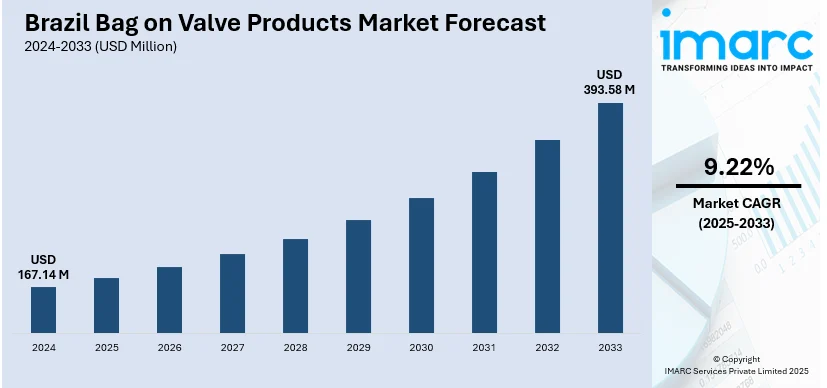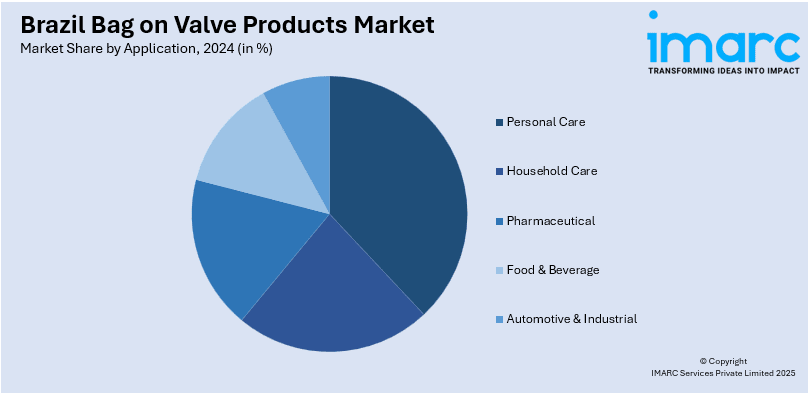
Brazil Bag on Valve Products Market Size, Share, Trends and Forecast by Application and Region, 2025-2033
Brazil Bag on Valve Products Market Overview:
The Brazil bag on valve products market size reached USD 167.14 Million in 2024. Looking forward, IMARC Group expects the market to reach USD 393.58 Million by 2033, exhibiting a growth rate (CAGR) of 9.22% during 2025-2033. The market is growing due to increased demand for eco-friendly packaging, expanding personal care and pharmaceutical sectors, and technological advancements in aerosol packaging, offering improved efficiency, sustainability, and product safety.
|
Report Attribute
|
Key Statistics
|
|---|---|
|
Base Year
|
2024
|
|
Forecast Years
|
2025-2033
|
|
Historical Years
|
2019-2024
|
| Market Size in 2024 | USD 167.14 Million |
| Market Forecast in 2033 | USD 393.58 Million |
| Market Growth Rate (2025-2033) | 9.22% |
Brazil Bag on Valve Products Market Trends:
Expanding Personal Care and Cosmetics Industry
The expansion of Brazil’s personal care and cosmetics industry is driving the growth of the bag on valve products market. For instance, the Brazilian association of the toiletries, perfumery and cosmetic industry (ABIHPEC) reports that the cosmetic industry exported goods valued at USD 911.2 million over the twelve months from January to December in 2023, representing a 14.5% increase relative to 2022. With consumers increasingly prioritizing convenience and product safety, BOV technology offers an ideal packaging solution by providing consistent spray performance, protecting product integrity, and extending shelf life. The Brazilian market’s demand for innovative packaging solutions for aerosols, particularly in the beauty and skincare sectors, is fueling the adoption of BOV systems, especially for sensitive formulations that benefit from the sterile barrier provided by this technology.

Increased Adoption in Pharmaceutical Sector
The pharmaceutical industry in Brazil is witnessing a rising adoption of bag on valve technology for medical products such as nasal sprays and topical treatments. BOV's ability to ensure product hygiene, prevent contamination, and deliver precise dosages has made it an attractive packaging solution in this sector. The application of BOV packaging is experiencing significant expansion, influenced by the rapid growth in the healthcare market, driven by increasing healthcare awareness and the demand for advanced drug delivery. For instance, according to the International Trade Administration report published in 2023, Brazil is the largest healthcare market in Latin America and spends 9.47% of its GDP on healthcare, which represents US$161 billion. This booming healthcare investments encourages innovations and supports the growth of packaging technologies like BOV, which offer enhanced product safety and extended shelf life. As pharmaceutical companies are increasingly focus on delivering higher safety standards and product efficacy, the adoption of BOV packaging is expected to continue rising, further driving the trend in Brazil’s evolving healthcare landscape.
Rising Demand for Eco-Friendly Packaging Solutions
Brazil's bag on valve (BOV) products market is experiencing increased demand due to the growing emphasis on sustainable and eco-friendly packaging. The expansion in the country’s economy and increasing consumer spending have significantly catalyzed the demand for various packaged products across industries, including food and beverage (F&B), pharmaceuticals, and cosmetics. For instance, according to industry reports by the IMARC Group, the Brazil packaging market is expected to show a growth rate (CAGR) of 4.01% from 2024 to 2032. BOV technology minimizes the use of harmful propellants and allows for nearly complete product usage, reducing waste. This packaging innovation aligns with environmental regulations and consumer preferences for greener solutions, making it popular among industries such as personal care and household products. As brands seek to enhance their environmental credentials, BOV packaging is gaining traction as an effective solution for reducing carbon footprints while maintaining product efficacy and quality.
Brazil Bag on Valve Products Market Segmentation:
IMARC Group provides an analysis of the key trends in each segment of the market, along with forecasts at the regional level for 2025-2033. Our report has categorized the market based on application.
Application Insights:

- Personal Care
- Liquid Soap & Shampoo
- Hair Gels & Shaving Products
- Cosmetic Products
- Household Care
- Household Cleaner
- Insecticides
- Air Fresheners
- Others
- Pharmaceutical
- Nasal Sprays
- Wound Cleaners
- Others
- Food & Beverage
- Whipped Cream
- Toppings & Dressings
- Others
- Automotive & Industrial
- Waxes
- Cleaning Products
- Others
The report has provided a detailed breakup and analysis of the market based on the application. This includes personal care (liquid soap & shampoo, hair gels & shaving products, and cosmetic products), household care (household cleaner, insecticides, air fresheners, and others), pharmaceutical (nasal sprays, wound cleaners, and others), food & beverage (whipped cream, toppings & dressings, and others), and automotive & industrial (waxes, cleaning products, and others).
Regional Insights:
- Southeast
- South
- Northeast
- North
- Central-West
The report has also provided a comprehensive analysis of all the major regional markets, which include Southeast, South, Northeast, North, and Central-West.
Competitive Landscape:
The market research report has also provided a comprehensive analysis of the competitive landscape. Competitive analysis such as market structure, key player positioning, top winning strategies, competitive dashboard, and company evaluation quadrant has been covered in the report. Also, detailed profiles of all major companies have been provided.
Brazil Bag on Valve Products Market Report Coverage:
| Report Features | Details |
|---|---|
| Base Year of the Analysis | 2024 |
| Historical Period | 2019-2024 |
| Forecast Period | 2025-2033 |
| Units | Million USD |
| Scope of the Report | Exploration of Historical Trends and Market Outlook, Industry Catalysts and Challenges, Segment-Wise Historical and Future Market Assessment:
|
| Applications Covered |
|
| Regions Covered | Southeast, South, Northeast, North, Central-West |
| Customization Scope | 10% Free Customization |
| Post-Sale Analyst Support | 10-12 Weeks |
| Delivery Format | PDF and Excel through Email (We can also provide the editable version of the report in PPT/Word format on special request) |
Key Questions Answered in This Report:
- How has the Brazil bag on valve products market performed so far and how will it perform in the coming years?
- What is the breakup of the Brazil bag on valve products market on the basis of application?
- What is the breakup of the Brazil bag on valve products market on the basis of region?
- What are the various stages in the value chain of the Brazil bag on valve products market?
- What are the key driving factors and challenges in the Brazil bag on valve products?
- What is the structure of the Brazil bag on valve products market and who are the key players?
- What is the degree of competition in the Brazil bag on valve products market?
Key Benefits for Stakeholders:
- IMARC’s industry report offers a comprehensive quantitative analysis of various market segments, historical and current market trends, market forecasts, and dynamics of the Brazil bag on valve products market from 2019-2033.
- The research report provides the latest information on the market drivers, challenges, and opportunities in the Brazil bag on valve products market.
- Porter's five forces analysis assist stakeholders in assessing the impact of new entrants, competitive rivalry, supplier power, buyer power, and the threat of substitution. It helps stakeholders to analyze the level of competition within the Brazil bag on valve products industry and its attractiveness.
- Competitive landscape allows stakeholders to understand their competitive environment and provides an insight into the current positions of key players in the market.
Need more help?
- Speak to our experienced analysts for insights on the current market scenarios.
- Include additional segments and countries to customize the report as per your requirement.
- Gain an unparalleled competitive advantage in your domain by understanding how to utilize the report and positively impacting your operations and revenue.
- For further assistance, please connect with our analysts.
 Inquire Before Buying
Inquire Before Buying
 Speak to an Analyst
Speak to an Analyst
 Request Brochure
Request Brochure
 Request Customization
Request Customization




.webp)




.webp)












